Piping Flange Isolation Kits and Gaskets
GPT flange isolation(insulation) products are constructed of premium engineering materials. The isolation products include a wide selection of isolating/sealing gaskets along with a variety of sleeves and washers. For maximum flexibility, components may be ordered separately or as part of complete flange isolation kits (FIK).
Flange Isolation Kits are designed to work in conjunction with our isolating gaskets to effect the complete electrical isolation of a flanged assembly. The Isolation Kits consist of one full-length isolating sleeve, two isolating washers and two steel washers for each of the bolts in the flange assembly. The purpose of the isolating sleeves is to electrically separate the bolts from each side of the flange, while the isolating washers provide electrical isolation for each of the nuts attached to the bolts. This method of isolation provides the user with a high-reliability solution to complete the electrical isolation of a flanged joint.
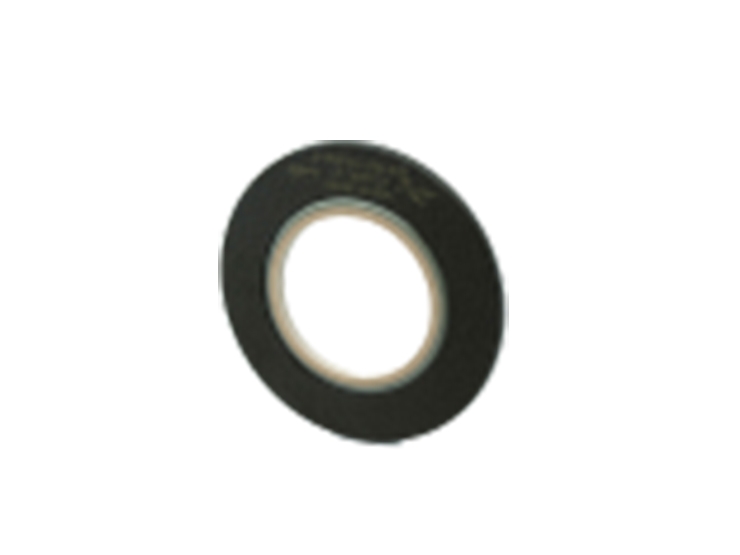
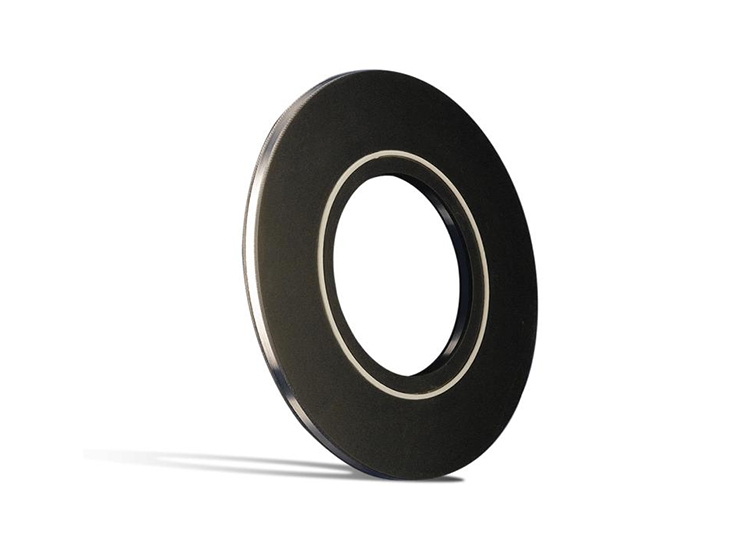
The Pikotek® VCS® gasket provides exceptional insulating and general sealing performance in aggressive material applications. The VCS gasket is suitable in all services up to and including ANSI 2500# and API 10,000# classes.¹
Due to its unique pressure activated sealing mechanism, the gasket requires far less bolt stress to seal than any other gasket.² The VCS gasket inner diameter is exactly matched to the flange bore to eliminate turbulent flow and flange face erosion/corrosion. The seal elements are replaceable in the reusable gasket retainer.
¹ As per design review. Please contact GPT product engineering for further information.
² Please see GPT Torque Calculator
Tandem seal versions available 6” and up and as standard for 24” and up – contact GPT engineering for other size availability.
Note: Electrical values are based on laboratory conditioned samples in laboratory conditions. Exposure to moisture or elevated temperature will change values- per each test standard (ASTM, etc)
¹ As per design review. Please contact GPT product engineering for further information. Contact us
³ Please see VCS Data Sheet for further information
G-10 NEMA grade G-10 Glass-Reinforced Epoxy (GRE) laminate material:
⁴ As per certificate Z1303
⁵ As per NAM Shell Design certificate
G-11 NEMA LI1 grade G-11 Glass-Reinforced Epoxy (GRE) laminate material:
One isolating and sealing gasket, VCS Type “F”, 0.260” thick or .308” thick, 316 stainless steel core retainer laminated on both sides with a G-10 fiber glass reinforced laminate containing a precision tapered groove to accommodate the controlled compression of a PTFE spring energized seal. Sealing element placement shall accommodate either flat, raised or RTJ face flanges. The PTFE seal shall be spring and pressure energized. The G-10 retainer shall have a 800 volts/mil dielectric strength and a minimum 66,000 psi compressive strength. The I.D. of the flange isolating gasket shall match the bore of the flange in which it is installed.
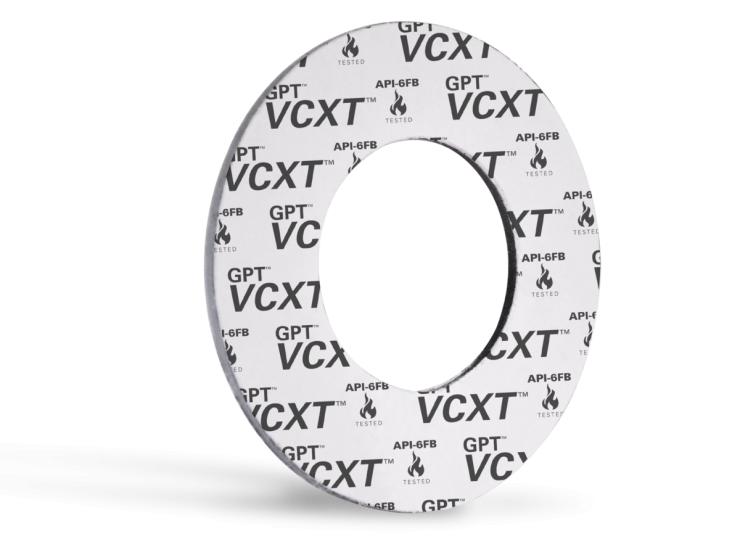
The VCXT™ high temperature flange insulation sets create a seal and maintain electrical isolation across a wide range of seating stresses and flange classes in elevated temperature service. They can be used in load compromised connections; such as damaged and/or lined flanges and also heavily bolted connections where significant gasket stresses may be generated.
The insulating gaskets and washers have been designed and developed for use in standard pipeline flanges where both cathodic protection and high integrity sealing are required at elevated service temperatures. For non-standard bolted connections please consult your regional GPT sales manager.
Note: Electrical values are based on laboratory conditioned samples in laboratory conditions. Exposure to moisture or elevated temperature will change values.
Other washer material can be provided to suit the application
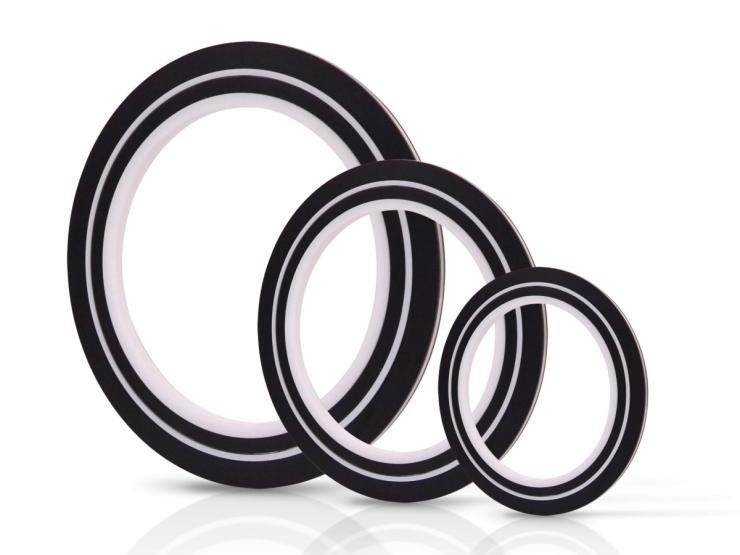
The VCS-ID® (Inside Diameter) Seal introduces an internal, machined PTFE seal at the bore of the existing VCS design platform. The use of a patented interlocking mechanism ensures an extremely tight seal at the bore and resistance to effects from internal pressure or aggressive media. The interlocking mechanism is intentionally designed to be approximately 0.100” larger than the pipe ID.
During installation/loading, the interlocking mechanism will compress to a final state that is slightly larger than the pipe ID. This reduces cavitation in the piping, reduces flange erosion and helps prevent microbiologically induced corrosion (MIC), while not affecting any line pigging operations.
Additionally, the PTFE interlocking mechanism creates a longer effective isolating distance than the standard platform.Traditional VCS gaskets leave the steel core exposed to the media. This increases the likelihood of the formation of an electrically conductive bridge between the flange face and steel core of the gasket, especially if the media contains conductive particles that lead to sediment build-up in the pipeline. Because the thickness of the inner PTFE seal is the same as the gasket thickness, the formation of an electrical bridge caused by conductive sediment build-up between the gasket steel core and the flange face is eliminated. Further, PTFE is not hygroscopic, so it does not have a tendency to absorb water, making it even more attractive as front line defense in electrical isolation. This unique design helps solve problems where hydrotested lines may no longer isolate.
Our patented interlocking mechanism is “dual locking” to provide a secure seal that won’t dislodge during handling, transport or installation. The “dual locking” feature creates a positive lock in both vertical and radial directions.
The interlocking mechanism also eliminates the need for exotic metal gasket core material because it breaks the metal-to-metal path. Obtaining exotic metals can cause long lead times and extra expense that are eliminated with the use of a VCS-ID seal.
Another benefit of the VCS-ID seal is that PTFE doesn’t have an affinity for water absorption, installations where electrical isolation testing is performed shortly after hydro-test are less likely to be c orrupted.The VCS-ID does not require any more torque than the standard VCS or VCFS, making installation simple using the same specification charts.
One isolating and sealing gasket, VCS-ID Type “F”, 0.260” thick or .308” thick, 316 stainless steel core retainer laminated on both sides with a G-10 fiber glass reinforced laminate containing a patented, mechanically locking PTFE sealing element. The PTFE element will be concave on the I.D. to induce pressure activation. The PTFE sealing element will be approximately 0.100” larger than the bore. Sealing element placement shall accommodate either flat, raised or RTJ face flanges. The G-10 retainer shall have a 800 volts/mil dielectric strength and a minimum 65,000 psi compressive strength.
Note: Physical, mechanical, and electrical properties are obtained through testing of material samples in laboratory controlled environments. Exposure to moisture or elevated temperature will change values.
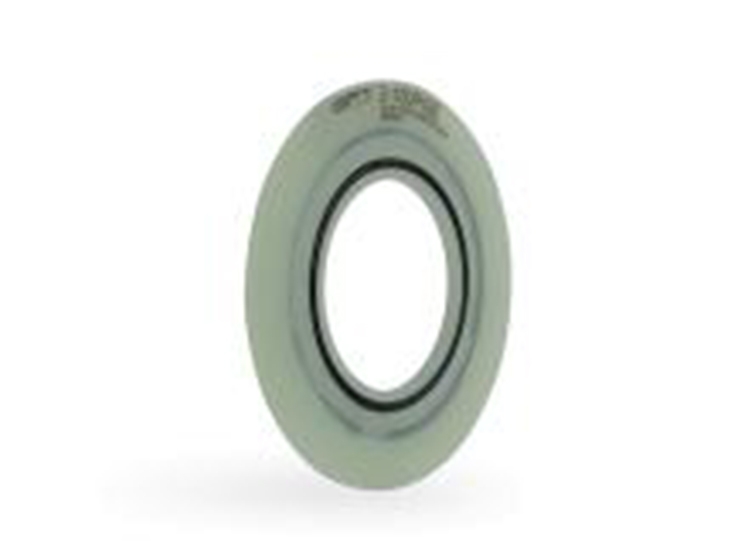
The PGE™ was designed to give operators an alternative to the failure prone phenolic-based isolating gaskets. The unique design of the PGE™ system incorporates patented overlapping and offsetting seal grooves. The purpose of this design is to break each layer of laminate within the gasket itself, thereby creating a barrier through which fluid and/or gas cannot migrate. The sealing element can be any elastomeric material, as well as more sophisticated spring-energized PTFE lip seals. As a result of this advanced seal design, maintenance-free flange isolation and flange face corrosion mitigation are achieved economically. Depending upon the sealing element selected, the PGE™ is rated for most hydrocarbon and water service applications.
This gasket is suitable for use in raised-face and flat-face flanges in ANSI Class 150, 300 and 600 service¹ (or equivalent). In addition to providing electrical isolation, the gasket is excellent for isolating flanges made of dissimilar metals or where prevention of flange face corrosion is desired.
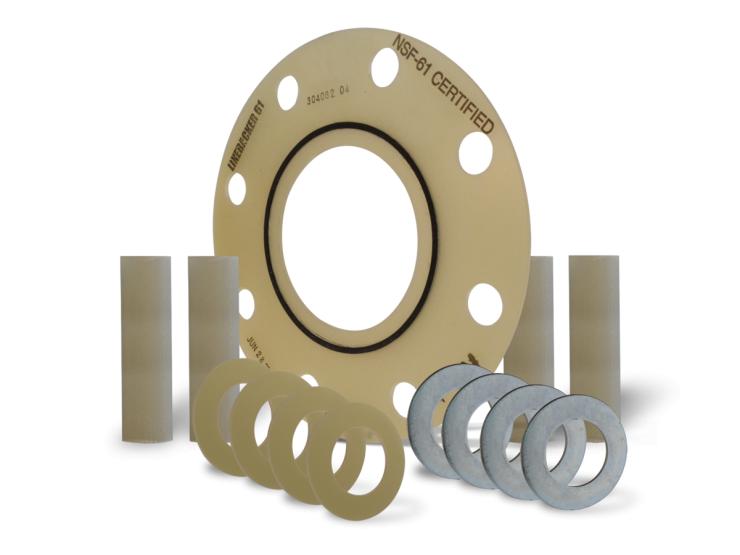
NSF/ANSI Standard 61 establishes minimum health effects requirements for the chemical contaminants and impurities that may be indirectly imparted to drinking water. The LineBacker® 61™ Sealing/Isolating gasket is certified to conform with all criteria associated with NSF health effects testing, certification and production facility inspections.
Of particular importance with respect to NSF/ANSI Standard 61, is the micro-exposure of the sealing element (EPDM) within the G-10 Epoxy Glass retainer material. In addition to providing positive sealing characteristics relative to the fluid flowing in the pipe, the sealing element is also fully encapsulated between the flange and GRE retainer, reducing exposure of the sealing element to harsh outside atmospheric conditions.
For more information regarding NSF, please contact GPT Engineering.
| Max Temperature | +302°F /+150°C |
| ASTM | Test Method | G-10 Epoxy Glass |
| D149 | Dielectric Strength: | Volts/Mil(Short Time):690 |
| D229 | Water Absorption: | 0.22 % |
| D790 | Flexural Strength: | LW 66,000 psi / CW 60,000 psi (413,685 kPa) |
| D785 | Hardness Rockwell “M”: | 99 |
| D638 | Tensile Strength: | LW 45,000 psi / CW 39,000 psi (310,264 kPa) |
| D732 | Shear Strength: | 19,000 psi (151,684 kPa) |
| Temperature Range | EPDM |
| Fahrenheit | -40° to +212° |
| Celsius | -40° to +100° |
Materials for flange isolation kits on pipes containing drinking/potable water (up to 280ºF (138ºC)) shall consist of the following components:
Isolating and Sealing Gasket
The full faced, NSF 61 certified, isolating and sealing gasket shall be LineBacker® 61™ Sealing Gasket (LB61) – Type “E”, 1/8” thick, G-10 retainer containing a precision tapered groove to accommodate the controlled compression of a EPDM quad-ring sealing element. Sealing element placement shall accommodate either flat, raised face or RTJ flanges. The quad-ring seal shall be pressure energized. The G-10 retainer shall have a 550 volts/mil dielectric strength and a minimum 50,000 psi compressive strength. The full-faced flange isolating gasket (weld-neck) shall be equal to or slightly smaller than the bore of the flange; (slip-on) shall be equal to or smaller than the I.D. of mating pipe.
Full Length Bolt Isolating Sleeves
One full length G-10 sleeve (extending half way into both steel washers) for each flange bolt. The G-10 shall be a 1/32” thick tube with a 400 volts/mil dielectric strength and water absorption of 0.10% or less.
Washers
Two, 1/8” thick, G-10 isolating washers for each bolt. Their compressive strength shall be 50,000 psi, dielectric strength 550 volts/mil and water absorption 0.10% or less. Two, 1/8″ thick zinc plated, hot-rolled steel washers for each bolt. The I.D. of all washers shall fit over the isolating sleeve and both the steel and isolating washers shall have a same I.D. and O.D.
Quality – (Made in U.S.A – A.R.R.A Compliant)
Flange isolating kits shall be manufactured at a facility that has a registered ISO 9001 Quality Management System. Submittals shall include copy of valid ISO registration and NSF 61 certification.
Before Tightening
The flange faces come into contact with the sealing elements, which extend slightly above the surface of the retainer. As the flange is tightened the sealing elements are compressed and move sideways into the inclined portion of the groove, developing a high unit pressure against the flange faces.
After Tightening
The flange faces have come into firm contact with the retainer, thus encapsulating the sealing elements within grooves. At the same time, the unique LineBacker® seal configuration provides elastic memory for elastomers not normally associated with this characteristic – resulting in a simple flat gasket with extremely high loading and self energizing characteristics without adverse cold flow problems.
TYPE E GASKET (Full Face)
The gasket retainer extends out to the O.D. of the flange. Holes are cut at the bolt circle to accommodate threaded studs or bolts. If in doubt about whether to use an “E” type gasket or an “F” type gasket, select an “E” type gasket as it will perform well in both flange types. An “F” type gasket only performs well in “F” type flange design.
TYPE F GASKET
The gasket retainer extends out to the I.D. of the bolt circle.
Copyright © 2023 Erith, All Rights Reserved